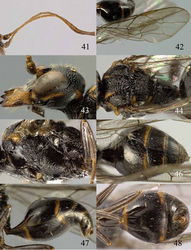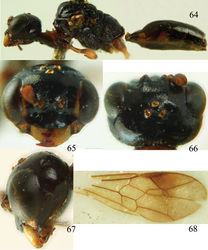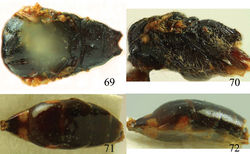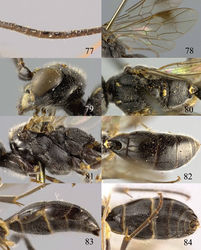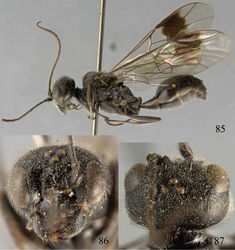| Notice: |
This page is derived from the original publication listed below, whose author(s) should always be credited. Further contributors may edit and improve the content of this page and, consequently, need to be credited as well (see page history). Any assessment of factual correctness requires a careful review of the original article as well as of subsequent contributions.
If you are uncertain whether your planned contribution is correct or not, we suggest that you use the associated discussion page instead of editing the page directly.
This page should be cited as follows (rationale):
Chen H, van Achterberg C, He J, Xu Z (2014) A revision of the Chinese Trigonalyidae (Hymenoptera, Trigonalyoidea). ZooKeys 385 : 1–207, doi. Versioned wiki page: 2014-02-28, version 42410, https://species-id.net/w/index.php?title=Jezonogonalos&oldid=42410 , contributors (alphabetical order): Pensoft Publishers.
Citation formats to copy and paste
BibTeX:
@article{Chen2014ZooKeys385,
author = {Chen, Hua-yan AND van Achterberg, Cornelis AND He, Jun-hua AND Xu, Zai-fu},
journal = {ZooKeys},
publisher = {Pensoft Publishers},
title = {A revision of the Chinese Trigonalyidae (Hymenoptera, Trigonalyoidea)},
year = {2014},
volume = {385},
issue = {},
pages = {1--207},
doi = {10.3897/zookeys.385.6560},
url = {http://www.pensoft.net/journals/zookeys/article/6560/abstract},
note = {Versioned wiki page: 2014-02-28, version 42410, https://species-id.net/w/index.php?title=Jezonogonalos&oldid=42410 , contributors (alphabetical order): Pensoft Publishers.}
}
RIS/ Endnote:
Wikipedia/ Citizendium:
See also the citation download page at the journal. |
Taxonavigation
Ordo: Hymenoptera
Familia: Trigonalyidae
Name
Jezonogonalos Tsuneki, 1991 re-instated – Wikispecies link – Pensoft Profile
Diagnosis
Length of body 6.6–12.0 mm; antenna black and with 23–27 segments; area above supra-antennal elevations flat, more or less punctate, without protuberance between elevations and inner side of supra-antennal elevations flat, smooth and black (Figs 40, 55, 66, 75, 87, 98); tyloids on 11th–14th antennal segments of male short and nearly circular or elliptical (Figs 51, 56, 77, 100; unknown of Jezonogonalos laeviceps and Jezonogonalos nigrata sp. n.); occipital carina widened medio-dorsally; apical segment of labial palp widened and obtuse, more or less triangular; vertex normal, at most with slight median depression dorsally (Fig. 75); mandibles wide in anterior view and sublaterally attached to head (Fig. 39); metanotum strongly convex and finely sculptured medially (Fig. 59); anterior propodeal sulcus crenulate and medially widened (Fig. 59); posterior propodeal carina curved and distinctly protruding and more or less separated from foramen medio-dorsally (Figs 44, 59, 69, 80, 93, 103); fore wing with large dark patch below pterostigma; vein 1-SR of fore wing long (Figs 42, 57, 68, 78, 89, 101); hind trochanter black or ivory; hind tarsus slightly or not modified; second and third sternites of + flat and moderately sclerotized and no protuberances (Figs 48, 72, 95, 107); body without pale pattern, at most malar space and margins of basal metasomal sternites and tergites narrowly ivory, remainder black.
Biology
Unknown.
Notes
Jezonogonalos Tsuneki was treated as valid genus in the revision by Carmean and Kimsey (1998)[1] and synonymized with Pseudogonalos Schulz by Lelej (1995)[2]. We agree with Carmean and Kimsey (1998)[1] that the shape of the supra-antennal elevations is different enough to retain both genera as valid.
Key to species of Jezonogonalos Tsuneki, 1991
Taxon Treatment
- Chen, H; van Achterberg, C; He, J; Xu, Z; 2014: A revision of the Chinese Trigonalyidae (Hymenoptera, Trigonalyoidea) ZooKeys, 385: 1-207. doi
Other References
- ↑ 1.0 1.1 1.2 Carmean D, Kimsey L (1998) Phylogenetic revision of the parasitoid wasp family Trigonalidae (Hymenoptera). Systematic Entomology 23: 35–76. doi: 10.1046/j.1365-3113.1998.00042.x
- ↑ 2.0 2.1 Lelej A (1995) [Fam. Trigonalidae - Trigonalid wasps]. In: Kupianskaya A Lelej A Storozheva N (Eds) [Key to the insects of Russian Far East] IV(2): 8–14. [in Russian]
Images
| Figures 29–33. Jezonogonalos marujamae Tsuneki, 1991, holotype, female. 29 Habitus lateral 30 head anterior 31 head dorsal 32 head lateral 33 fore and hind wings. |
| Figures 34–37. Jezonogonalos marujamae Tsuneki, 1991, holotype, female. 34 Mesosoma dorsal 35 mesosoma lateral 36 metasoma lateral 37 metasoma ventral. |
| Figures 41–48. Jezonogonalos elliptifera sp. n., holotype, female. 41 Antennae 42 fore wing 43 head lateral 44 mesosoma dorsal 45 mesosoma lateral 46 metasoma dorsal 47 metasoma lateral 48 metasoma ventral. |
| Figures 49–52. Jezonogonalos elliptifera sp. n., paratype, male. 49 Habitus lateral 50 antenna 51 tyloids on 11th–15th segments of antenna 52 metasoma lateral. |
| Figures 56–63. Jezonogonalos jiangliae sp. n., holotype, male. 56 Tyloids on 11th–15th segments of antenna 57 fore and hind wings 58 head lateral 59 mesosoma dorsal 60 mesosoma lateral 61 metasoma dorsal 62 metasoma lateral 63 metasoma ventral. |
| Figures 64–68. Jezonogonalos laeviceps (Tsuneki, 1991), holotype, female. 64 Habitus lateral 65 head anterior 66 head dorsal 67 head lateral 68 fore wing. |
| Figures 69–72. Jezonogonalos laeviceps (Tsuneki, 1991), holotype, female. 69 Mesosoma dorsal 70 mesosoma lateral 71 metasoma dorsal 72 metasoma lateral. |
| Figures 73–76. Jezonogonalos luteata sp. n., holotype, male. 73 Habitus lateral 74 head anterior 75 head dorsal 76 antennae. |
| Figures 77–84. Jezonogonalos luteata sp. n., holotype, male. 77 Tyloids on 10th–16th segments of antenna 78 fore and hind wings 79 head lateral 80 mesosoma dorsal 81 mesosoma lateral 82 metasoma dorsal 83 metasoma lateral 84 metasoma ventral. |
| Figures 85–87. Jezonogonalos nigrata sp. n., holotype, female. 85 Habitus lateral 86 head anterior 87 head dorsal. |
| Figures 88–95. Jezonogonalos nigrata sp. n., holotype, female. 88 Antenna 89 fore and hind wings 90 head lateral 91 mesosoma dorsal 92 mesosoma lateral 93 metasoma dorsal 94 metasoma lateral 95 metasoma ventral. |
| Figures 96–99. Jezonogonalos satoi (Tsuneki, 1991), holotype, male. 96 Habitus lateral 97 head anterior 98 head dorsal 99 antennae. |
| Figures 100–107. Jezonogonalos satoi (Tsuneki, 1991), holotype, male. 100 Tyloids on 10th–16th segments of antenna 101 fore and hind wings 102 head lateral 103 mesosoma dorsal 104 mesosoma lateral 105 metasoma dorsal 106 metasoma lateral 107 metasoma ventral. |
|



